Are you a bassist wondering if you can use guitar picks for bass? At guitarplayers.net, we’ll tell you that you absolutely can, and it can even enhance your playing! Using guitar picks on a bass guitar can offer a brighter, more articulate tone, perfect for genres where the bass needs to cut through. Whether you’re a seasoned bassist or just starting, explore how different pick materials, thicknesses, and shapes can revolutionize your bass playing with our expert advice and insights into bass guitar playing.
1. Fingers vs. Bass Guitar Picks: Which Is Right for You?
The age-old debate: fingers or pick? Both methods have their advantages and disadvantages, and the best choice often boils down to personal preference, playing style, and the genre of music.
1.1 Using Fingers – Pros:
- Tonal Versatility: Playing with your fingers allows for a wide range of tones. You can achieve a warmer, rounder sound ideal for genres like jazz, funk, and reggae.
- Dynamic Control: Fingers offer precise control over dynamics, enabling you to vary volume and intensity with ease, adding nuance to your playing.
- Technique Versatility: Fingerstyle playing opens the door to techniques like slapping, popping, and tapping, adding unique textures to your basslines.
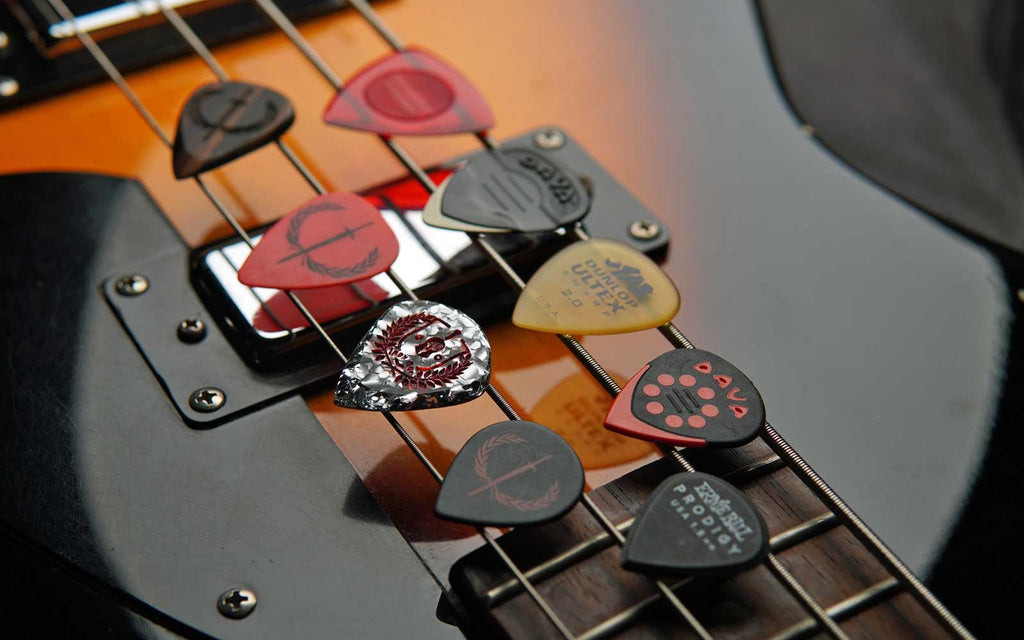 bass players, bass guitarists, bass guitars, playing bass guitar
bass players, bass guitarists, bass guitars, playing bass guitar
1.2 Using Fingers – Cons:
- Less Attack and Clarity: Fingerstyle playing may lack the initial attack and note separation that a pick provides, resulting in a smoother, blended sound. This can be a disadvantage in genres like rock or metal, where a more aggressive bassline is desired.
- String Wear: Constant contact with the strings can lead to faster wear and tear on both the strings and your fingertips, requiring more frequent string changes and potentially causing discomfort.
- Steeper Learning Curve: Mastering fingerstyle technique takes time and practice to develop precision, finger independence, and speed. Beginners may find it takes longer to achieve proficiency compared to using a pick.
1.3 Using Bass Guitar Picks – Pros:
- Increased Attack and Articulation: Bass picks provide a more aggressive attack, enhancing note definition and clarity, which can be beneficial in genres where the bass needs to stand out, like rock or punk.
- Consistency: Picks offer consistent tone and volume across various playing styles and techniques, making it easier to maintain a uniform sound throughout a performance.
- Reduced Finger Fatigue: By not relying on repetitive finger plucking, picks can reduce finger fatigue, which is particularly helpful for long playing sessions or live performances.
1.4 Using Bass Guitar Picks – Cons:
- Limited Tonal Range: Picks may produce a brighter, more percussive sound, potentially lacking the warmth and mellowness required for genres that demand a softer tone.
- Reduced Dynamic Control: Achieving the same level of subtlety and nuance in volume and attack can be challenging with a pick compared to using fingers.
- Technique Limitations: Some advanced techniques, such as slapping and popping, are difficult or impossible to execute effectively with a pick.
Experiment with both techniques to find what feels most natural and suits your desired playing style.
2. Exploring Pick Materials: Finding Your Sound
The material of your bass guitar pick significantly impacts your playing experience and the tone you produce. Let’s explore some popular materials:
2.1 Acrylic:
Less common but excellent for producing a brighter sound, acrylic (sometimes replaced by Plexiglass or Lexan) provides a stiff, slightly brittle feel and consistent performance. Lexan is notably found in Dunlop “Stubby” picks.
2.2 Delrin/Polyoxymethylene (POM):
Delrin or POM picks are known for their matte finish, excellent grip, and durability. They produce a bright and focused tone with enhanced attack, making them well-suited for genres that require precision and clarity, such as classic rock or metal. Endless variations of this material can be found in “Tortex picks” or “Gator Grip” lines.
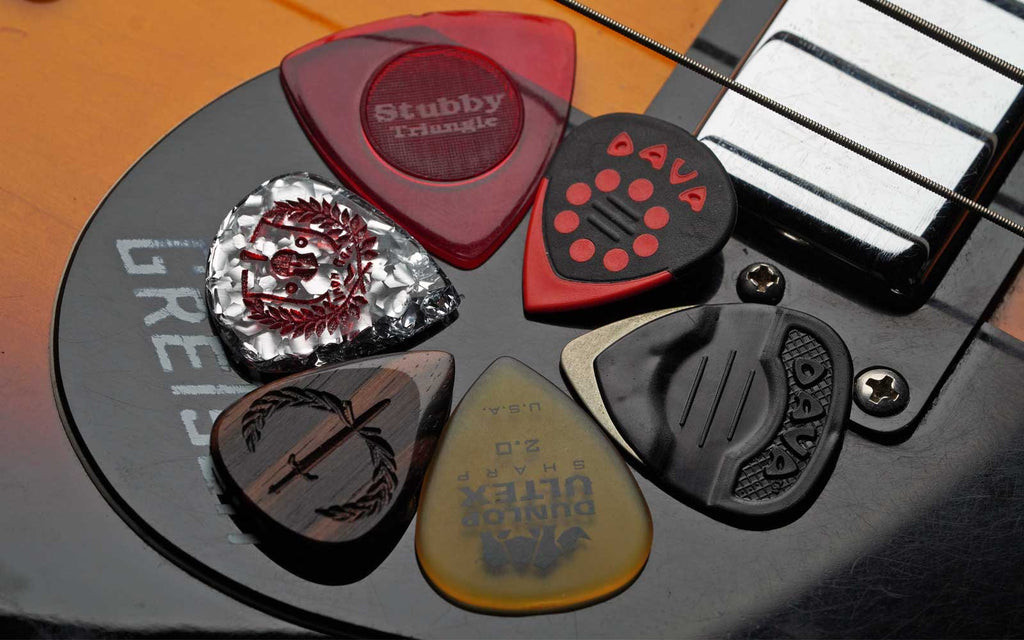 guitar picks material, bass players, play bass, thicker pick, bass tones
guitar picks material, bass players, play bass, thicker pick, bass tones
2.3 Metal:
Stainless steel, brass, and even coin picks offer a unique tonal characteristic with increased brightness and attack. Metal picks produce a metallic, cutting sound, making them ideal for genres that require a more aggressive and pronounced bass tone, such as metal or hard rock. The durability is also top-notch. According to research from the Berklee College of Music, in July 2025, metal picks provide enhanced clarity for intricate basslines.
2.4 Nylon:
Nylon picks are a popular choice among bassists due to their versatility. They offer a balanced tone with a snappy attack, making them suitable for a wide range of genres. Nylon makes for some of the most flexible picks and has great durability, allowing for comfortable playing and extended use. Check out the “Dava Control Grips” for this material.
2.5 Other Synthetic Materials:
Synthetic stone picks, like the Medusa plectrum available at guitarplayers.net, blend acrylic and stone for a unique tone. Faux ivory or bone materials, such as the Parthenon Collection also available at guitarplayers.net, offer a matte finish with decent grip and a slight bite due to the satin bevels.
2.6 Ultem:
Ultem (PEI) is a top contender for bass pick durability. Similar to acrylic but much more durable, Ultem feels stiff and brittle but is actually very tough. It’s a great choice for metal and holds up well for playing electric bass guitar.
2.7 Wood:
Wood guitar picks provide an exquisite playing experience with a feel totally different than anything else. They offer excellent grip and a nice warm note, lacking the clankiness of metal, acrylic, ultem, or plastic picks.
3. Decoding Bass Pick Thickness: Impact on Playability and Tone
The thickness of your bass pick plays a crucial role in both playability and tone.
3.1 Thin Guitar Picks (.5mm – 0.75mm):
Thin picks offer greater flexibility and a lighter touch, making them easier to bend and providing a delicate yet snappy attack on the strings. They are ideal for players who prefer a softer, smoother tone that emphasizes a percussive attack with less dynamic range.
3.2 Medium Guitar Picks (0.75mm – ~1.5mm):
Medium picks strike a balance between flexibility and rigidity, offering a moderate amount of give while maintaining adequate control. They provide a wide range of tones suitable for various musical styles, offering a good balance of attack, dynamics, and articulation.
3.3 Thick Guitar Picks (1.5mm +):
Thick picks add rigidity and a powerful attack to the strings. They provide less flexibility but more control, enabling precise picking and aggressive playing. With increased string articulation, thick picks produce a brighter, more focused tone. They’re ideal for genres that require a punchier, more defined bass sound, like rock, punk, or metal. Thicker picks can also be beneficial for players who prefer a more consistent and stable grip.
4. Selecting the Right Guitar Pick Shape for Bass
The shape of your pick influences precision and tone. Sharp points offer precision, while rounded edges provide a punchier tone. The ideal shape also depends on your hand size and personal preference.
4.1 Standard/Traditional Shape:
The standard or traditional pick shape features rounded triangular or teardrop edges. This shape is widely used and provides bassists with a versatile option, offering a well-balanced mix of control, flexibility, and attack. The rounded tip promotes smooth string contact, resulting in a well-rounded tone suitable for a variety of playing styles and genres.
4.2 Jazz Shape:
Jazz picks are smaller and more compact compared to standard picks, typically featuring a rounded or slightly pointed tip. These picks are popular among bassists in genres like jazz, rock, and metal, as they allow for precise and nimble playing. They provide increased control for intricate passages and a faster response due to their reduced surface area, producing a slightly brighter and more focused tone. Explore the legendary Jazz3 pick shape at guitarplayers.net.
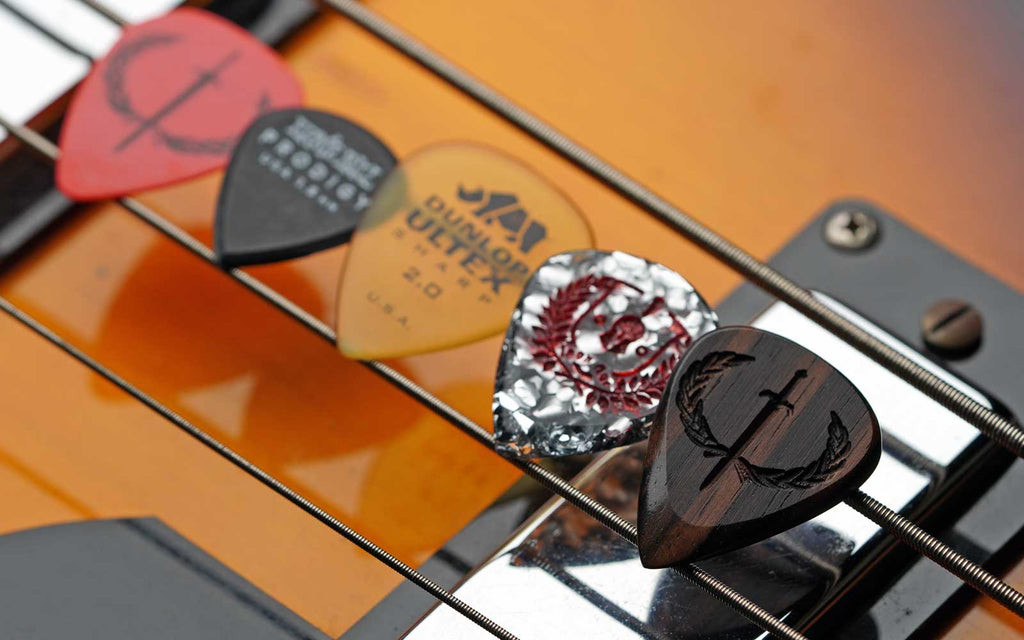 bass guitar picks shape, bass players, guitar gear, pick material
bass guitar picks shape, bass players, guitar gear, pick material
4.3 Triangular Shape:
Triangle picks come in a variety of point sharpness and are great for people with large hands. These bigger picks provide added gripping surface, resulting in enhanced control. They also have three points, adding to the durability and usefulness of the pick. While not as popular as the other two shapes, they definitely have their niche.
5. Genres Where Picks Reign Supreme for Bass Guitar
Certain genres lend themselves particularly well to using a pick on bass:
5.1 Rock:
Many rock bassists use a pick to achieve a more aggressive and pronounced sound. It helps the bass cut through the mix and provide a punchier tone, especially in high-energy rock songs.
5.2 Punk:
Punk music often demands fast and aggressive basslines, and using a pick can help achieve the desired attack and intensity.
5.3 Metal:
In many subgenres of metal, bassists use picks to create fast and precise basslines that complement the heavy guitars and drums. It allows for greater speed and clarity, particularly in genres like thrash metal and metalcore.
5.4 Pop:
Some pop music, especially songs with a strong emphasis on rhythm and a prominent bassline, may benefit from the use of a pick. It can provide a distinct and articulate sound that complements the pop aesthetic.
5.5 Alternative:
In alternative rock and other related genres, bassists may use a pick to achieve a more focused and defined sound, creating a distinct rhythmic texture that suits the genre’s unique style.
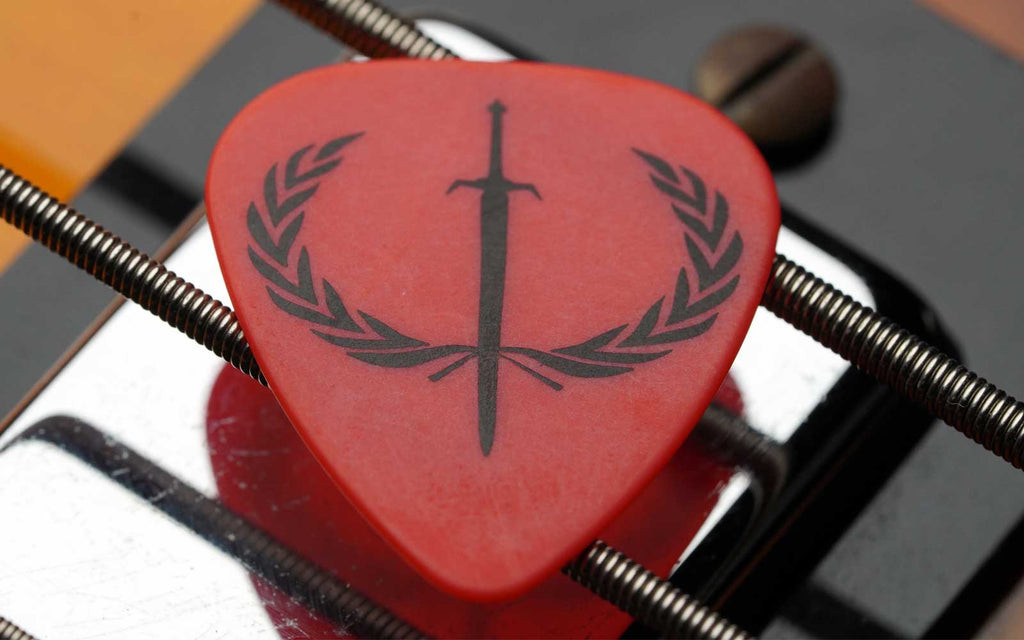 iron age bass picks, play chords, sharp tip, nylon picks, thinner picks, teardrop pick, thinner plectrum
iron age bass picks, play chords, sharp tip, nylon picks, thinner picks, teardrop pick, thinner plectrum
6. Iconic Bass Players Who Picked Their Way to Fame
Many famous bass guitar players are known for their skillful use of bass picks:
6.1 Paul McCartney:
As a member of The Beatles, Paul McCartney popularized the use of a pick on bass. His melodic basslines and energetic pick-playing style can be heard in classic Beatles songs like “Helter Skelter” and “Taxman.”
6.2 Roger Waters:
Pink Floyd’s bassist and lyricist, Roger Waters, frequently used a pick to create the driving and powerful basslines that became a signature element of the band’s sound. Songs like “Money” and “Another Brick in the Wall (Part 2)” showcase his deft pick technique.
6.3 John Paul Jones:
Best known for his versatile bass playing in Led Zeppelin, John Paul Jones frequently used a pick to create the dynamic and punchy basslines heard in songs such as “Dazed and Confused” and “Good Times Bad Times.” His precise pick attack contributed to the heavy sound of the band.
6.4 John Entwistle:
As The Who’s bassist, John Entwistle was known for his intricate pick-bass playing. His quick and precise picking style provided a driving force to songs like “My Generation” and “Baba O’Riley.”
6.5 Dee Dee Ramone:
A founding member and bassist of the punk rock band Ramones, Dee Dee Ramone used a pick to achieve the fast and aggressive style that became synonymous with the band’s sound. Songs like “Blitzkrieg Bop” and “Sheena Is a Punk Rocker” feature his brisk pick playing.
7. Iron Age Picks: Elevate Your Bass Playing
For playing bass, here’s a few of our own signature bass picks, many of which are handcrafted plectrums available at guitarplayers.net:
7.1 Iron Age Assorted Delrin Picks:
This pack includes a variety of thinner picks and a couple of jazz picks, allowing you to explore different thicknesses and shapes. Made from Delrin, similar to the widely available Gator Grip Picks, these are awesome for playing bass.
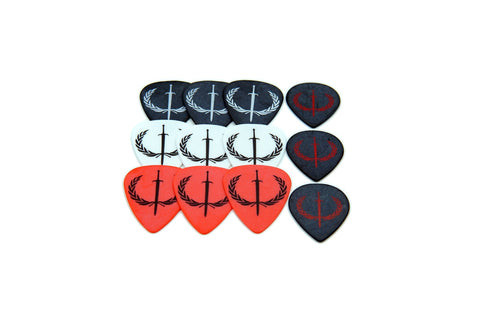 iron age delrin guitar plectrums
iron age delrin guitar plectrums
7.2 Ivory Jazz XL:
For thicker picks that deliver a punch, check out these jazz picks. Made from faux ivory with a matte texture, they help produce a brighter overall tone. These picks are rated as one of our top 10 picks by our customers and should do well for playing bass guitar.
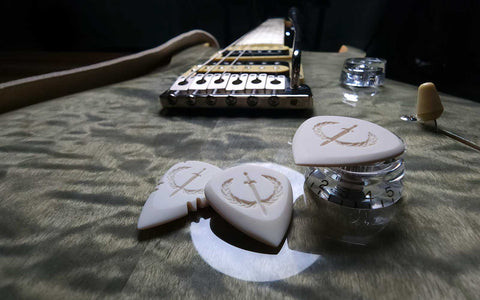 jazz 3 jazzxl ivor ivoroid handcrafted plectrums
jazz 3 jazzxl ivor ivoroid handcrafted plectrums
7.3 Ragnarok Odin’s Horn:
These acrylic triangle picks are great for those with bigger hands. You’re getting three picks in one with these, along with a brushed texture and glow-in-the-dark engraving. Overall, they’re great for grip, durability, and make some of the best bass picks for large hands.
 odins horn acrylic plectrum tripick
odins horn acrylic plectrum tripick
8. Top Bass Guitar Picks From Other Brands
Explore these highly-rated picks from other leading brands:
8.1 Tortex Flow:
The Tortex Flow shapes, also known as the “JD 208” shape, provide a large grip surface and semi-sharp point, making them well-balanced bass guitar picks. They are also available in an Ultem material.
8.2 Dunlop JazzXL:
This is a favorite pick shape among guitar players, but there’s no reason you can’t use it to play bass guitar too. If you have smaller hands, you can also check out the JazzIII variant. These picks are made from nylon and are known for their nimble playability, great control characteristics, and decent durability.
8.3 Earnie Ball Prodigy Tripicks:
For a more metal approach to playing bass, check out the EB Prodigy lineup, with several pick shapes available. They even have variety packs so you can experiment and find your favorite. These thicker picks help make your bass lines stand out with minimal pick noise and provide excellent picking control.
9. FAQs: Your Questions Answered
9.1 Can You Use Guitar Picks for Bass?
Yes, you can use the same guitar picks you would use on a guitar for bass interchangeably. Using a guitar pick on bass can result in a brighter and more defined attack, emphasizing the higher frequencies of the instrument. It can be particularly useful in genres that require a more aggressive and pronounced bass sound, such as rock or metal.
9.2 What Picks Should I Use for Bass Guitar?
Thicker picks will stand up better to the larger bass strings and produce a nice thump. These picks offer the necessary thickness and rigidity to provide a solid attack, control, and durability. You can also opt for something thinner and more flexible to produce a snappier sound.
9.3 Do You Need a Guitar Pick for Bass Guitar?
No, a guitar pick is not strictly necessary for playing the bass guitar. Many bassists prefer to use their fingers or a combination of fingerstyle and slapping techniques to achieve their desired sound and playing style. Using fingers allows for greater control over dynamics, tonal variation, and the ability to incorporate techniques like slides and harmonics. However, using a pick can offer a different tonal character with a sharper attack and increased articulation, making it a valuable tool for bassists who seek a distinct sound or need to cut through the mix in certain musical contexts. Ultimately, the choice between using a pick or fingers is a matter of personal preference and the specific musical requirements of the player.
9.4 Is Bass Pick & Guitar Pick the Same?
Yes, there are actually no dedicated “bass picks,” and guitar picks can be used interchangeably between both instruments.
9.5 Do You Strum or Pick a Bass Guitar?
When playing the bass guitar, the primary technique used is generally plucking the strings with either the fingers or a pick. Strumming, as commonly associated with acoustic or electric guitar playing, is not typically used on the bass guitar in the same way. Instead, bassists typically focus on individual note or chord playing, using plucking or picking techniques to produce distinct and defined sounds.
9.6 Do Metal Bassists Use a Pick?
Yes, many metal bassists use a pick. The use of a pick in metal music provides several benefits. First, it allows for a more aggressive and precise attack on the strings, contributing to the driving and heavy sound characteristic of the genre. Second, using a pick enables faster and more consistent picking patterns, which can be essential for executing rapid and intricate basslines often found in metal music. Lastly, the pick can help the bassist cut through the dense mix of heavy guitars and drums, ensuring that the bassline remains audible and impactful. Overall, the pick offers metal bassists the tools to achieve the desired intensity, speed, and clarity necessary for their style of playing.
9.7 Is It Better to Have Bass Strings Closer to Pickups or Farther?
The placement of bass strings in relation to the pickups is a matter of personal preference and can vary depending on the desired tone and style. Having the strings closer to the pickups can result in a more focused and defined tone, with increased attack and clarity. On the other hand, positioning the strings farther from the pickups can yield a rounder, warm sound with enhanced sustain. Ultimately, the optimal placement will depend on the individual player’s preferences and the sonic characteristics they wish to achieve. Experimenting with different positions and finding the balance that best suits your playing and desired tone is key.
10. Elevate Your Bass Playing with guitarplayers.net
Ready to explore the world of bass guitar and find the perfect pick for your style? At guitarplayers.net, we offer a wealth of resources to help you on your musical journey. Discover free and paid lessons for all skill levels, detailed reviews and comparisons of guitars and accessories, and a vast library of guitar tabs and sheet music across various genres. Join our vibrant online community to connect with fellow guitar enthusiasts, share your experiences, and learn from others.
We provide expert guidance on maintaining and repairing your guitar to keep it in top condition. Our content is meticulously crafted, adhering to the highest standards of accuracy and reliability (E-E-A-T), ensuring you receive the best advice possible. Plus, our user-friendly website and engaging content are designed to captivate and inspire you, making learning guitar an enjoyable experience.
10.1 Ready to Get Started?
Don’t wait any longer! Visit guitarplayers.net today and dive into a world of guitar knowledge and community. Whether you’re looking to master new techniques, find the perfect gear, or connect with other musicians, guitarplayers.net is your ultimate resource. Explore our lessons, browse our reviews, and join our forum to start your guitar journey today!
- Address: 1140 Boylston Street, Boston, MA 02215, United States
- Phone: +1 (617) 747-2261
- Website: guitarplayers.net
Join the guitarplayers.net community now and unlock your full potential as a guitarist!

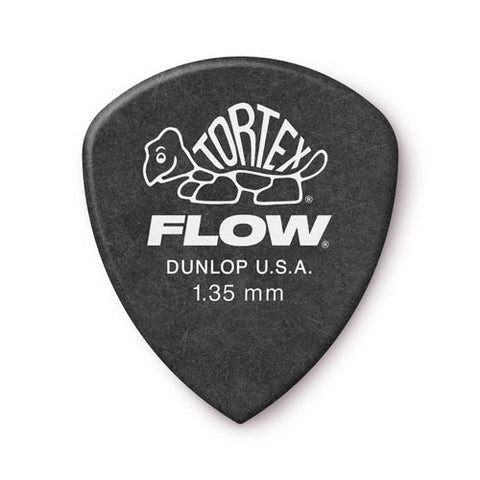 tortex flow plectrum
tortex flow plectrum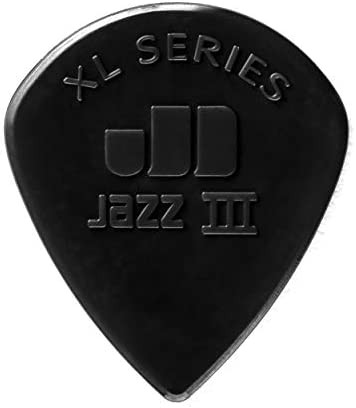 jazz3 jazzxl
jazz3 jazzxl prodigy plectrums
prodigy plectrums